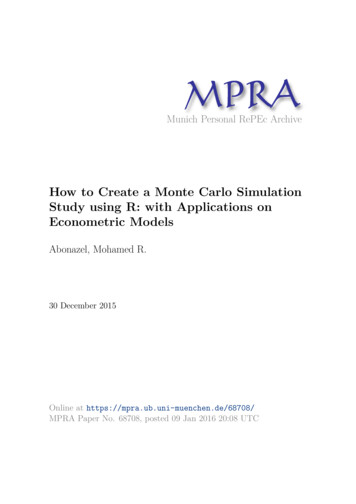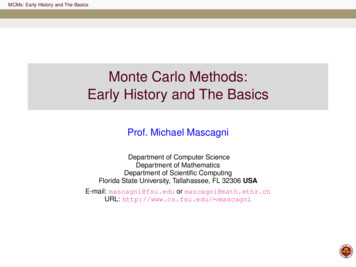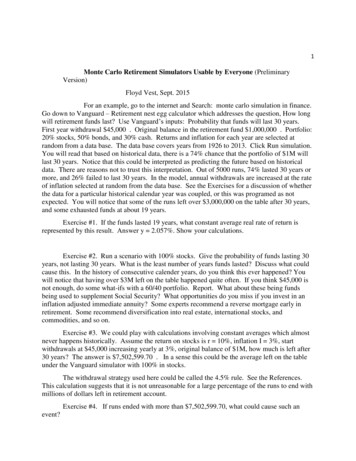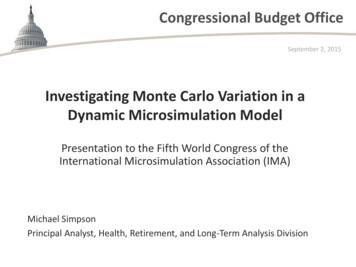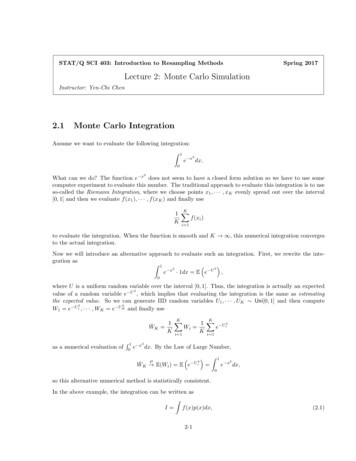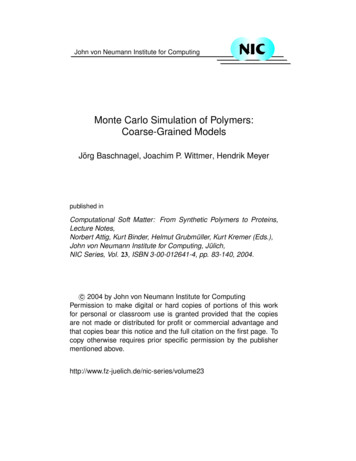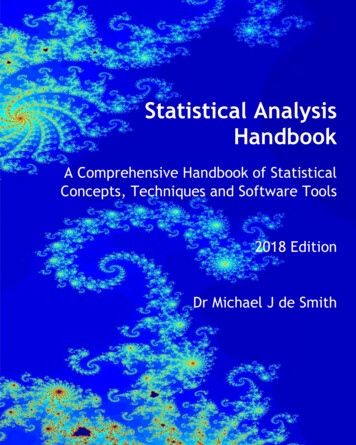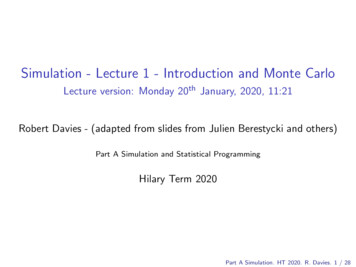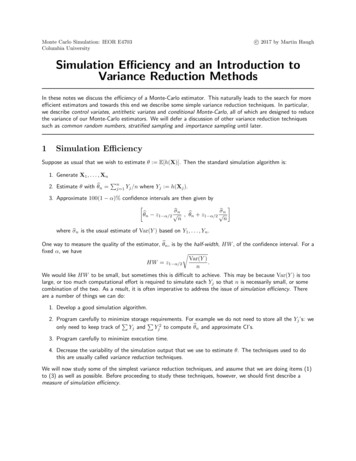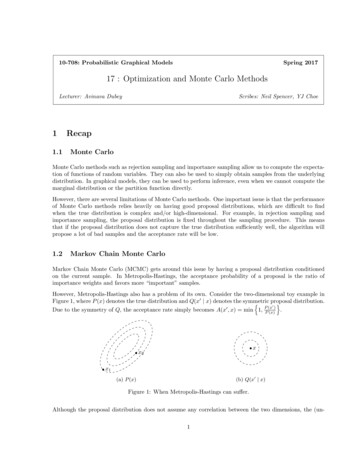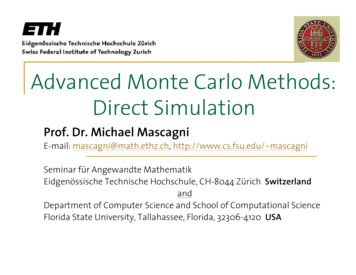
Transcription
Advanced Monte Carlo Methods:Direct SimulationProf. Dr. Michael MascagniE-mail: mascagni@math.ethz.ch, http://www.cs.fsu.edu/ mascagniSeminar für Angewandte MathematikEidgenössische Technische Hochschule, CH-8044 Zürich SwitzerlandandDepartment of Computer Science and School of Computational ScienceFlorida State University, Tallahassee, Florida, 32306-4120 USA
Direct Simulation Probabilistic Problem or ModelDirectly simulate the physical random processes of the originalproblemReplace complicated “blocks” with randomized outcomes (neutronics)Direct the simulation’s random outcomes with random numbersExamplesControlling floodwater and construction of new dams on the Niles The quantity of water in the river varies randomly from season to seasonUse records of weather, rainfall, and water levels extending over manyyearsExamine what may happen to the water if certain dams are built andcertain possible policies of water control are exercisedEvaluate artificial lake impact on people, agriculture, transportation,antiquitiesProf. Dr. Michael Mascagni: Advanced Monte Carlo MethodsDirect SimulationSlide 2 of 16
Direct Simulation (Cont.)Examples (Cont.) Telephone networksComputer networksGrowth of an insect population on the basis of certain assumed vital statisticsof survival and reproductionService rates (queuing theory)Operations research problemsActuarial simulations Insurance risk from tabulated date (mortality)Risk assessment of investment portfoliosComputer gamesRoadway design simulationWar gamingProf. Dr. Michael Mascagni: Advanced Monte Carlo MethodsDirect SimulationSlide 3 of 16
Direct Simulation of the Lifetime ofComets A Long-period Comet Described as a sequence of elliptic orbits Sun at one focus of the orbit ellipseEnergy of a comet is inversely proportional to the lengthof the semi-major axis of the ellipseProf. Dr. Michael Mascagni: Advanced Monte Carlo MethodsDirect SimulationSlide 4 of 16
Direct Simulation of the Lifetime ofComets (Cont.) Behavior of the Comet Most of the time Moves at a great distance from the sunA relatively short time (instantaneous) Passes through the immediate vicinity of the sun and the planetsAt this instant, the gravitational field of the planet perturbs thecometary energy by a random componentSuccessive energy perturbations (in suitable units of energy) may betaken as independent normally distributed random variables η1, η2,η3, , ηnη1, η2, η3, , ηn can be normalized to, for example, a standard normaldistribution, N(0,1)Computing the perturbations exactly is dauntingProf. Dr. Michael Mascagni: Advanced Monte Carlo MethodsDirect SimulationSlide 5 of 16
Direct Simulation of the Lifetime ofComets (Cont.) Comets under perturbation A comet, starting with an energy, G –z0, has subsequent energies The process continues until the first occasion on which z changessign (negative bound state; positive free state) -z0, -z1 -z0 η1, -z2 -z1 η2, Once z changes sign, the comet departs on a hyperbolic orbit and islost from the solar systemKepler’s Third Law the time taken to describe an orbit with energy –z is z-3/2 the total lifetime of the comet is zT is the first negative quantity in the sequence of z0, z1, Prof. Dr. Michael Mascagni: Advanced Monte Carlo MethodsDirect SimulationSlide 6 of 16
Direct Simulation of the Lifetime ofComets (Cont.) Problem is to determine distribution of Ggiven z0 Very difficult problem in theoretical mechanicsEasy to simulate using probabilistic modelSeek CDF: Prof. Dr. Michael Mascagni: Advanced Monte Carlo MethodsDirect SimulationSlide 7 of 16
Direct Simulation of the Lifetime ofComets (Cont.) Monte Carlo trick: use analytic/deterministicinformation when it is available Probability of escape in one orbit (available from N(0,1) tables:Know also:Prof. Dr. Michael Mascagni: Advanced Monte Carlo MethodsDirect SimulationSlide 8 of 16
Direct Simulation of the Lifetime ofComets (Cont.) Now we need to estimate: N* samples (subsample) out of N have T 1Let 1-p*(g) be the proportion of values in thesubsample with G gProf. Dr. Michael Mascagni: Advanced Monte Carlo MethodsDirect SimulationSlide 9 of 16
Direct Simulation of the Lifetime ofComets (Cont.) Using conditional probability we have:Prof. Dr. Michael Mascagni: Advanced Monte Carlo MethodsDirect SimulationSlide 10 of 16
A Robotics Problem Take symmetric, concentric objects, O1 and O2in random orientations: what is thedistribution of the smallest angle needed torotate one into coincidence with the other?There is an analytic solution, but forsimulation need to generate randomorientations via random 3x3 orthogonalmatricesProf. Dr. Michael Mascagni: Advanced Monte Carlo MethodsDirect SimulationSlide 11 of 16
A Robotics Problem (Cont.) Let Q0 [x; y; z] where the vectors x, y, z areuniformly distributed on S2x (x1, x2, x3) x -1 is uniform on S2 when x1, x2, x3are i.i.d. N(0,1) random variablesSimilarly define y* (y1, y2, y3) y* -1Take y (y* – Px)/(1 – P2)1/2 where P x y*(Gram-Schmidt procedure)Prof. Dr. Michael Mascagni: Advanced Monte Carlo MethodsDirect SimulationSlide 12 of 16
A Robotics Problem (Cont.) Finally, let z x x y which is orthogonal to theothers Prof. Dr. Michael Mascagni: Advanced Monte Carlo MethodsDirect SimulationSlide 13 of 16
Dimensional Analysis Consider the “Traveling Salesman” problem:given n towns to visit, no order, minimize theHamiltonian path through the Euclideanweighted complete graphLet l be the length of the shortest pathA total area of region containing citiesn/A is the density of citiesProf. Dr. Michael Mascagni: Advanced Monte Carlo MethodsDirect SimulationSlide 14 of 16
Dimensional Analysis (Cont.) Assume l Aa(n/A)b nbA(a-b)Units l – lengthn – dimensionless (number)A – (length)2Implies a-b ½Prof. Dr. Michael Mascagni: Advanced Monte Carlo MethodsDirect SimulationSlide 15 of 16
Dimensional Analysis (Cont.) Multiply the area by f while keeping thedensity constant, l is also multiplied by f fA replaces Afn replaces nfl replaces ll nbA1/2 implies fl fbnbf1/2A1/2 so b ½l k (nA)1/2 strictly via dimensional analysisProf. Dr. Michael Mascagni: Advanced Monte Carlo MethodsDirect SimulationSlide 16 of 16
Prof. Dr. Michael Mascagni: Advanced Monte Carlo Methods Direct Simulation Slide 5 of 16 Direct Simulation of the Lifetime of Comets (Cont.) Behavior of the Comet Most of the time Moves at a great distance from the sun A relatively short time (instantaneous) Passes through the immediate vicinity of the sun and the planets At this instant, the gravitational field of the planet perturbs the
